
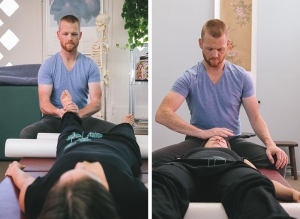

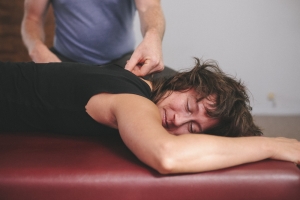

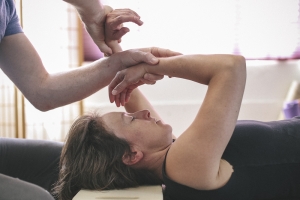
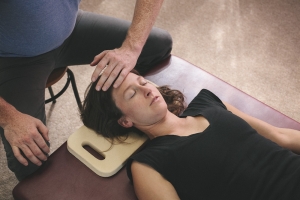
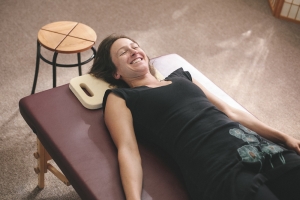
Functional Integration lessons may be given to the student in many different configurations: lying on the table in some way, sitting, standing, walking. The student remains fully clothed. Depending on the request of the student, their particular organization at the onset of the lesson, and the intention of the practitioner, each lesson will be unique. Oftentimes the practitioner will begin by touching and moving the student in small ways, clarifying the shape of the skeleton, accentuating the organizational shape of the student, and taking over the work of muscles in the student that are latently or chronically contracted, thereby offering them rest and quiescence. During this time a pleasant, effortless quality of movement is enacted and sensed. One of the hallmarks of Functional Integration is the experience of effortless movement, the experience of which will be remembered and preferred at later times by the student spontaneously.
As the lesson continues, the practitioner and student, collaborating through movement, will explore and clarify a variety of skeletal connections, and possibilities for movement, continuing to operate in the effortless and pleasant range, although the range of movements may grow. As more and more of the student is exposed to awareness through movement, there will be a growing sense of movement that involves the entire person, that is organized efficiently, and that is more spontaneously ready to enact any intention.
The immediate effect of a Functional Integration lesson can vary greatly, especially given the fact that any number of themes may have just been explored. The student will sense some difference from before the lesson started, sometimes subtle and sometimes very profound, that will often blossom and grow over the course of the next several hours or even days.
In my own experience, I often feel in an altered state when I first finish receiving a Functional Integration lesson. Usually I feel incredibly light and lithe, and I can sense a very great deal of myself to be at the disposal of my intention. My movement is easy and interesting, and over the course of hours and days I settle into a different way of moving and sensing moving. I feel uninhibited and sometimes surprised at how much simpler and clearer my thinking is. It is an often unexpected consequence of Feldenkrais Method practice that the thinking becomes much more clear and unencumbered, and that suddenly one enacts their intentions with a great deal less hesitation than they are used to. This quality of potency to enact our intentions is central to Feldenkrais Method work, and accompanies whatever other improvement or healing that occurs.
In Feldenkrais Method practice we utilize the underlying connection of every part to the others. On this account, in Functional Integration a practitioner may seek to improve the functioning of the knee by improving mobility in the ankles and hips. Or address lower back pain by way of improved breathing and then a more free carriage of the head. By improving one aspect of ourselves, we can incite others to fall in line with this improved and preferred organization. On account of this seemingly circuitous course of action, often, after a Functional Integration lesson, a student may be surprised at the drastic difference they feel in places that were largely untouched, or, that the area they requested to be addressed may not have been touched directly by the practitioner. In fact they are already involved in a trajectory of learning that will suit them individually and will not feel imposed or artificial. They will improve, and also, learn of how to go about improving.